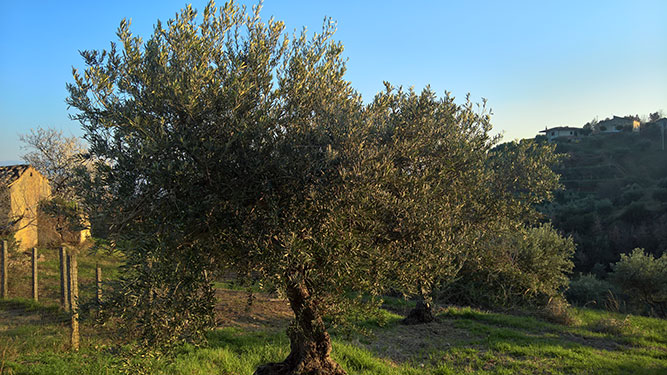Cultivar
In Calabria, the olive-growing heritage is vast, the result of the differentiation over time of at least 33 different olive cultivars, including: Borgese, Carolea, Cassanese di Lauropoli, Cerchiara, Chianota, Ciciarello, Corniola di Villapiana, Razza, Dolce di Rossano, Fecciaro, Fidusa, Grossa di Cassano, Grossa di Gerace, Mafra di Cerchiara, Melitana, Miseo, Napoletana, Nostrana di Amendolara, Ottobratica, Pargolea, Pennulara, Perciasacchi, Policastrese, Pugliasca, Rezza, Santomauro, Sinopolese, Squillaciota, Tombarello, Tonda di Strongoli, Tondina or Roggianella. In Altomonte, the most widespread cultivar is the Tondina or Roggianella (around 80% of all production). The harvest period begins in the last days of October and ends by the first week of January.
Translated with DeepL.com (free version)
Tondina is a typical plant that is not particularly widespread in other areas of Calabria, its shrub is small to medium-sized and it is a very hardy plant. Its low economic yield in terms of quantity (14-15%) is, however, compensated for by the benefits deriving from its function of self-maintenance of the hydro-geological and environmental balance, as it does not require any particular human treatment other than the normal cleaning and pruning of the plant. The oil that derives from its fruit is highly appreciated by experts in the sector because it is rich in aromas and flavours, plus it is very rich in those antioxidant substances typical of extra virgin olive oil.
Translated with DeepL.com (free version)


Lavorazione
Our oil preserves the characteristic flavours of the territory, produced by skilful craftsmanship, from the harvesting of the fruit to the milling in the oil mill: “u trappitu”, a point of reference for the families of Alto Adige who still produce for their own consumption.
Papaleo’s extra virgin olive oil is obtained by processing the best olives, carefully selected and coming exclusively from the territory of Altomonte and neighbouring countries. The prevailing harvesting method is hand picking, or using mechanical aids so as not to damage the fruit or the tree. The olives that arrive at the mill are stored in well-ventilated containers so as not to alter the freshness of the harvest.
Processing takes place using the most modern technology while maintaining the characteristics of a traditionally produced artisanal oil. The olives that arrive at the mill are first cleaned of harvest residues, then ground by granite millstones that crush the olives in a very natural way to obtain a homogeneous paste, which is then left to knead for about 35 minutes. The kneading takes place at controlled temperatures that do not exceed 27°C. At this stage the oil particles have the opportunity to unite, starting the separation from the water. In the next processing stage, using the “decanter”, exploiting the different specific weights, a more decisive separation takes place where, in addition to oil and water, the solid part (pomace) is separated and expelled.
The last stage of processing takes place in a vertical separator that manages to eliminate the last residues of vegetation water. The oil obtained is stored in special large-capacity stainless steel containers, where it is left to decant for a certain period and then bottled.
